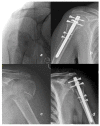Outcomes of Mini-Invasive Arthroscopic Arthrolysis Combined with Locking Screw and/or Intramedullary Nail Extraction after Osteosynthesis of the Proximal Humerus Fracture
- PMID: 35054056
- PMCID: PMC8778013
- DOI: 10.3390/jcm11020362
Outcomes of Mini-Invasive Arthroscopic Arthrolysis Combined with Locking Screw and/or Intramedullary Nail Extraction after Osteosynthesis of the Proximal Humerus Fracture
Abstract
Data on the effectiveness of arthroscopic arthrolysis and extraction of osteosynthetic material after osteosynthesis of the proximal humerus in patients with persisting problems are rare and insufficient. In this study, we performed arthroscopic arthrolysis and extraction of fixation screws, and, where protruding, extraction of the nail in 34 patients with problems persisting 12 months after osteosynthesis of the proximal humerus using an intramedullary nail. The effectiveness of the treatment was assessed using the Constant-Murley shoulder score and forward flexion difference between the treated arm and the contralateral one. A median increase of 16 points in CMS score and 30 degrees reduction in the arm forward flexion difference was recorded 12 months after the arthroscopy. The improvement was significantly higher in the patient group with intramedullary nail extraction (however, this group had worse pre-operative values and the screw was only extracted where likely to cause problems). The median time to heal was 11 weeks; no serious peri- or post-procedural complications occurred. Mini-invasive arthroscopic arthrolysis combined with extraction of osteosynthetic material proved to be a safe and effective method for treatment of patients after osteosynthesis of the proximal humerus using an intramedullary nail with persisting pain and/or mobility limitation.
Keywords: Constant–Murley shoulder score; arthrolysis; arthroscopy; extraction; intramedullary nail; post-operative dysfunction; proximal humerus fracture; screw; shoulder.
Conflict of interest statement
The authors have no conflict of interests to declare that are relevant to the content of this article.
Figures



References
Grants and funding
LinkOut - more resources
Full Text Sources

